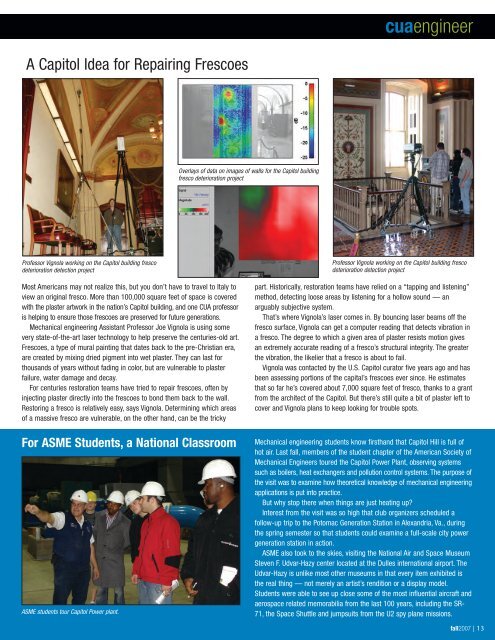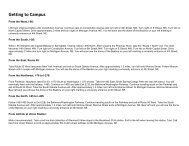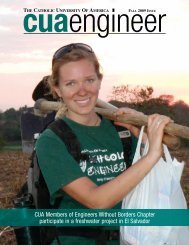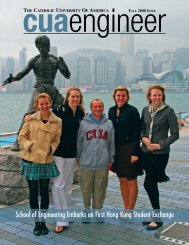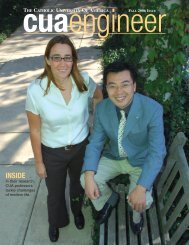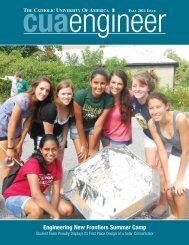cuaengineerIEEE Student ChapterWhat do an X-box and an iPod have in common?Besides mass-consumer appeal, <strong>the</strong>y both havefound <strong>the</strong>ir way into <strong>the</strong> creative designs <strong>of</strong> CUAelectrical engineers.The CUA student chapter <strong>of</strong> <strong>the</strong> Institute <strong>of</strong>Electrical and Electronics Engineers had a busyacademic year, putting a new spin on a classicphysics experiment, working with U.S. veteransat <strong>the</strong> National Rehabilitation Hospital, and <strong>of</strong>course, launching a few rockets.The Rubens’ Tube, also known as <strong>the</strong> standingwave flame tube, is a classic physics experimentfor electrical engineering students demonstratinga standing wave. It shows <strong>the</strong> relationship betweensound waves and air pressure. A length <strong>of</strong> pipeis perforated along <strong>the</strong> top and sealed at bo<strong>the</strong>nds—one seal attached to a small speaker, <strong>the</strong>o<strong>the</strong>r to a gas grill. Once <strong>the</strong> speaker is turnedon, pressure changes caused by <strong>the</strong> soundwaves will cause <strong>the</strong> flames to heighten in someareas and to lower in o<strong>the</strong>rs. That’s where <strong>the</strong>iPod comes in. This year, IEEE students hookedthat speaker up to <strong>the</strong> mp3 player, watchingpressure changes brought by classic rock.IEEE students also helped turn entertainmentinto rehabilitation, working with CUA pr<strong>of</strong>essorsin <strong>the</strong> Center for Applied Biomechanics andRehabilitation Research. The center has deviseda way to control a Micros<strong>of</strong>t X-Box video gamesystem so that soldiers with amputations cantrain <strong>the</strong>ir muscles in a fun, engaging manner.An artificial hand can be opened, closed ororientated by <strong>the</strong> amputee contracting <strong>the</strong>remaining muscles on his upper arm, but inorder to accurately control <strong>the</strong> artificial hand,a high level <strong>of</strong> skill is required to turn thosedriving muscles on and <strong>of</strong>f. Through intensivetraining, people can learn how to turn muscleson and <strong>of</strong>f in a highly efficient manner. CABBR,with <strong>the</strong> help <strong>of</strong> IEEE students, hoping tomake that intensive training a little moreentertaining — and giving veterans a chanceto enjoy a pastime so many Americans takefor granted: playing video games. (For more onthis initiative see page 14.)Seeing Better Through Fly’s EyeAssistant Pr<strong>of</strong>essor Scott Ma<strong>the</strong>ws and Associate Pr<strong>of</strong>essor Mark Mirotznik with <strong>the</strong> PERIODIC systemThrough its convex, compound eye, a fly createsan array <strong>of</strong> images, a panoramic view that enables<strong>the</strong> insect to detect motion 10 times faster than<strong>the</strong> human eye and so escape even <strong>the</strong> quickestflyswatter. Seeing and recording an array <strong>of</strong>images, however, <strong>of</strong>fers possibilities for visualinformation beyond <strong>the</strong> temporal. Department <strong>of</strong>Electrical Engineering and Computer ScienceAssociate Pr<strong>of</strong>essor Mark Miroztnik andAssistant Pr<strong>of</strong>essor Scott Ma<strong>the</strong>ws, along with amultidisciplinary, multi-site team <strong>of</strong> researchers,have married <strong>the</strong> “fly’s eye imaging system” toa computerized camera system, a PracticalEnhanced Resolution Integrated Optical DigitalImaging Camera, dubbed PERIODIC. “Arrayimaging systems are an important step in <strong>the</strong>design <strong>of</strong> optical-digital integrated imagingsystems,” says Miroztnik. “They outperformsingle-lens systems while maintaining a thinform and a wide angle <strong>of</strong> view.”The PERIODIC camera system resembles acircuit-board sandwich, with <strong>the</strong> array <strong>of</strong> lenseson <strong>the</strong> front and green circuit boards in <strong>the</strong> middlecarrying information to a computer. Mirotznikexplains, “The optical sensor and s<strong>of</strong>tware componentswork in concert to solve underlyingcomplex image registration and reconstructionproblems in near real-time and produce highdefinition, multi-layer images.”The prototype, funded by a DisruptiveTechnology Office challenge grant, greatlyimproves <strong>the</strong> resolution and dynamic range <strong>of</strong>imagery, removes glare and performs spectralfiltering. It has moved <strong>the</strong> emerging “array imagingparadigm,” Miroztnik says, “toward systemsthat can maximize <strong>the</strong> information content <strong>of</strong>images relative to a set <strong>of</strong> prescribed imagingtasks.” Such tasks include iris recognition biometricsachieved through super-resolution, glarereduction through polarization, extended depth <strong>of</strong>focus by changing <strong>the</strong> focal point <strong>of</strong> lenses andcombining those images, and enhanced dynamicrange through <strong>the</strong> use <strong>of</strong> neutral density filters.Miroztnik and his team are particularly gratifiedby application <strong>of</strong> <strong>the</strong> technology to burninjury assessment. “The most critical factorsdetermining whe<strong>the</strong>r or not burn patients recoverare rapid assessment <strong>of</strong> <strong>the</strong> degree <strong>of</strong> burnsand quick, appropriate treatment,” saysMiroztnik. Severe burns destroy subcutaneousblood vessels, decreasing <strong>the</strong> flow <strong>of</strong> blood tot<strong>issue</strong>s, which can result in <strong>the</strong> death <strong>of</strong> t<strong>issue</strong>and loss <strong>of</strong> limbs as well as significantly increasing<strong>the</strong> chance <strong>of</strong> life-threatening infection.“Using multi-spectral imaging through a 1650 nmspectral filter, we can accurately measure bloodoxygen levels in a patient’s skin and give doctors<strong>the</strong> rapid evaluation <strong>of</strong> <strong>the</strong> extent <strong>of</strong> t<strong>issue</strong> damage<strong>the</strong>y need to initiate appropriate treatment.”“With <strong>the</strong> PERIODIC camera system, we’veopened <strong>the</strong> door on <strong>the</strong> design and versatility <strong>of</strong>lenslet array systems,” Miroztnik concludes, “butwe’re looking forward to considering many moreaspects—<strong>the</strong> use <strong>of</strong> diffractives, GPU integrationand <strong>the</strong> difficult nonlinear numerical optimizationproblem <strong>of</strong> joint approaches for registration andreconstruction.”12 | cuaengineer
cuaengineerA Capitol Idea for Repairing FrescoesOverlays <strong>of</strong> data on images <strong>of</strong> walls for <strong>the</strong> Capitol buildingfresco deterioration projectPr<strong>of</strong>essor Vignola working on <strong>the</strong> Capitol building frescodeterioration detection projectMost Americans may not realize this, but you don’t have to travel to Italy toview an original fresco. More than 100,000 square feet <strong>of</strong> space is coveredwith <strong>the</strong> plaster artwork in <strong>the</strong> nation’s Capitol building, and one CUA pr<strong>of</strong>essoris helping to ensure those frescoes are preserved for future generations.Mechanical engineering Assistant Pr<strong>of</strong>essor Joe Vignola is using somevery state-<strong>of</strong>-<strong>the</strong>-art laser technology to help preserve <strong>the</strong> centuries-old art.Frescoes, a type <strong>of</strong> mural painting that dates back to <strong>the</strong> pre-Christian era,are created by mixing dried pigment into wet plaster. They can last forthousands <strong>of</strong> years without fading in color, but are vulnerable to plasterfailure, water damage and decay.For centuries restoration teams have tried to repair frescoes, <strong>of</strong>ten byinjecting plaster directly into <strong>the</strong> frescoes to bond <strong>the</strong>m back to <strong>the</strong> wall.Restoring a fresco is relatively easy, says Vignola. Determining which areas<strong>of</strong> a massive fresco are vulnerable, on <strong>the</strong> o<strong>the</strong>r hand, can be <strong>the</strong> trickyFor ASME Students, a National ClassroomASME students tour Capitol Power plant.Pr<strong>of</strong>essor Vignola working on <strong>the</strong> Capitol building frescodeterioration detection projectpart. Historically, restoration teams have relied on a “tapping and listening”method, detecting loose areas by listening for a hollow sound — anarguably subjective system.That’s where Vignola’s laser comes in. By bouncing laser beams <strong>of</strong>f <strong>the</strong>fresco surface, Vignola can get a computer reading that detects vibration ina fresco. The degree to which a given area <strong>of</strong> plaster resists motion givesan extremely accurate reading <strong>of</strong> a fresco’s structural integrity. The greater<strong>the</strong> vibration, <strong>the</strong> likelier that a fresco is about to fail.Vignola was contacted by <strong>the</strong> U.S. Capitol curator five years ago and hasbeen assessing portions <strong>of</strong> <strong>the</strong> capital’s frescoes ever since. He estimatesthat so far he’s covered about 7,000 square feet <strong>of</strong> fresco, thanks to a grantfrom <strong>the</strong> architect <strong>of</strong> <strong>the</strong> Capitol. But <strong>the</strong>re’s still quite a bit <strong>of</strong> plaster left tocover and Vignola plans to keep looking for trouble spots.Mechanical engineering students know firsthand that Capitol Hill is full <strong>of</strong>hot air. Last <strong>fall</strong>, members <strong>of</strong> <strong>the</strong> student chapter <strong>of</strong> <strong>the</strong> American Society <strong>of</strong>Mechanical Engineers toured <strong>the</strong> Capitol Power Plant, observing systemssuch as boilers, heat exchangers and pollution control systems. The purpose <strong>of</strong><strong>the</strong> visit was to examine how <strong>the</strong>oretical knowledge <strong>of</strong> mechanical engineeringapplications is put into practice.But why stop <strong>the</strong>re when things are just heating up?Interest from <strong>the</strong> visit was so high that club organizers scheduled afollow-up trip to <strong>the</strong> Potomac Generation Station in Alexandria, Va., during<strong>the</strong> spring semester so that students could examine a full-scale city powergeneration station in action.ASME also took to <strong>the</strong> skies, visiting <strong>the</strong> National Air and Space MuseumSteven F. Udvar-Hazy center located at <strong>the</strong> Dulles international airport. TheUdvar-Hazy is unlike most o<strong>the</strong>r museums in that every item exhibited is<strong>the</strong> real thing — not merely an artist’s rendition or a display model.Students were able to see up close some <strong>of</strong> <strong>the</strong> most influential aircraft andaerospace related memorabilia from <strong>the</strong> last 100 years, including <strong>the</strong> SR-71, <strong>the</strong> Space Shuttle and jumpsuits from <strong>the</strong> U2 spy plane missions.<strong>fall</strong><strong>2007</strong> | 13


